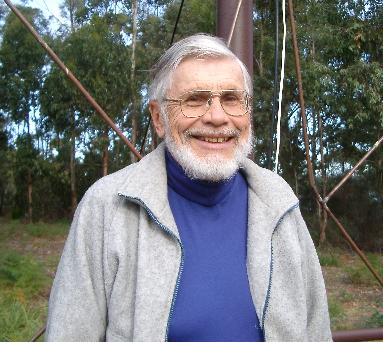 W.C. Erickson (Photo courtesy of Hilary Cane)
Article contributed by Kenneth I. Kellermann
W.C. Erickson (Photo courtesy of Hilary Cane)
Article contributed by Kenneth I. Kellermann
The 2005 Grote Reber Medal has been awarded to W. C. Erickson, Professor Emeritus at the University of Maryland and Honorary Research Associate at the University of Tasmania in Hobart, Australia. Erickson was recognized for his innovative contributions to radio astronomy, especially for developing novel techniques that have been the forerunner of electronically-steerable radio telescopes developed for meter wavelength-astronomy. Currently Erickson operates his own private radio observatory on Bruny Island in Tasmania where he observes solar radio emission. Earlier in his career Professor Erickson studied the turbulence in the solar corona, investigated the nature of the first fast millisecond pulsar, and made one of the first detections of very high Rydberg state atoms in the cold interstellar medium. More recently, he has been leading a group of his former students and others doing sub-arcminute resolution imaging of radio sources at 4-meter wavelength using instrumentation which they developed and installed on the NRAO VLA.
Professor Erickson obtained his undergraduate and graduate education at the University of Minnesota where he received his Ph.D. degree in 1956. Following appointments at St. Thomas College in Minnesota, the University of Minnesota, the Carnegie Institute, and the Convair/General Dynamics Corporation in California, Erickson spent a year in Leiden as the leader of the group developing the Benelux Cross Radio Telescope. While he was a professor at the University of Maryland from 1963 to 1988, Erickson, together with his students, developed a succession of innovative low-frequency radio telescopes at Clark Lake in the Anza-Borrego Desert east
of San Diego, California. Erickson has trained and inspired his many students, creating a group of skilled
scientists who, along with Erickson, are developing a new generation of meter wavelength radio telescopes.
The Grote Reber Medal is awarded annually for innovative lifetime contributions to radio astronomy. The Medal is administered by the Queen Victoria Museum in Launceston, Tasmania in cooperation with the University of Tasmania, the CSIRO Australia Telescope National Facility, and the U. S. National Radio Astronomy Observatory. The 2005 Prize will be awarded at a ceremony in early December 2005 during an international conference on radio astronomy being held at the University of Tasmania in Hobart, Australia.
The award of the Grote Reber Medal is made possible through funds provided by the estate of Grote Reber.
Modified on Tuesday, 19-Jul-2011 14:16:38 EDT by Ellen Bouton, Archivist (Questions or feedback)
|
![[IAU logo]](iau_wb_thumb.jpg)
![[URSI logo]](URSI-logo-thumb.jpg)
![[Karl Jansky at his antenna]](jansky_photo_02_thumb.jpg)
![[Reber's Wheaton antenna]](Reber_Telescope_Wheaton_thumb.jpg)
![[Dover Heights]](Dover_Heights_02_thumb.jpg)
![[4C telescope]](GB61-195_4C_telescope_thumb.jpg)
![[Ewen and horn antenna]](ewen_horn1s.jpg)
![[Dwingeloo, 1956]](Dwingeloo-1956-thumb.jpg)
![[Jocelyn Bell Burnell and Cambridge antenna used in pulsar discovery]](burnell2_thumb.jpg)
![[Lovell Telescope at Jodrell Bank]](site_1594_0001-500-334-20180316163019-thumb150.jpg)
![[Wilson, Penzias, and Bell Labs horn antenna]](wilson-penzias-horn_thumb.jpg)
![[6-m Millimeter Radio Telescope in Mitaka, Japan]](6m-thumb.jpg)

